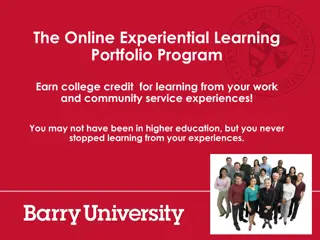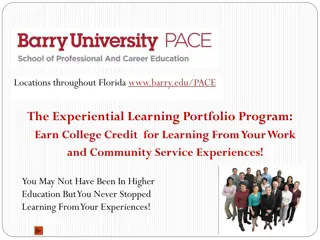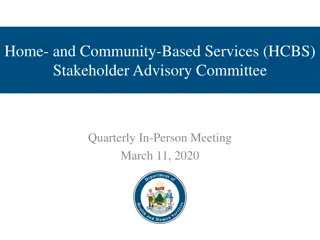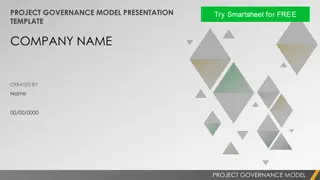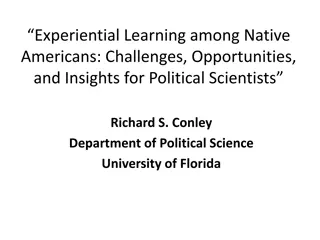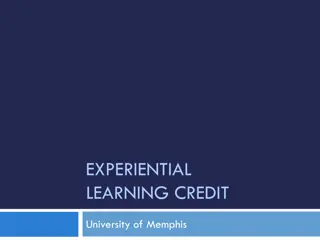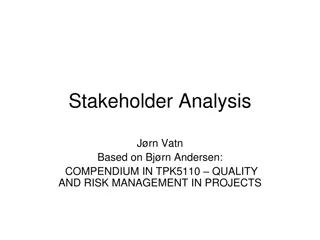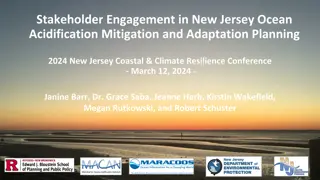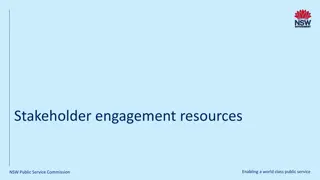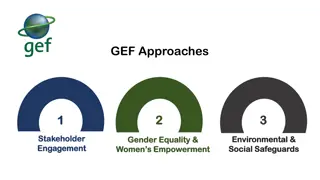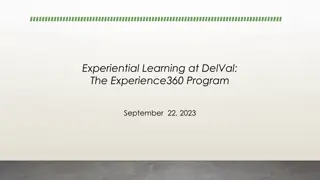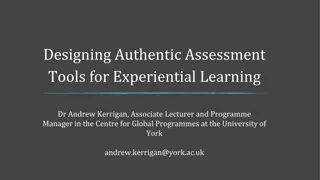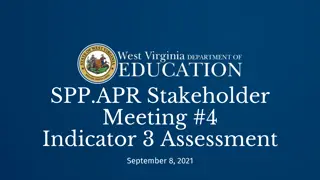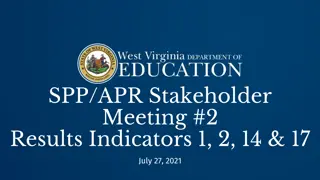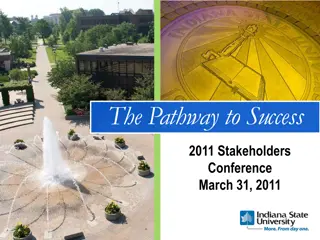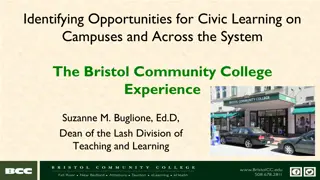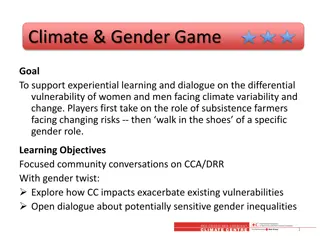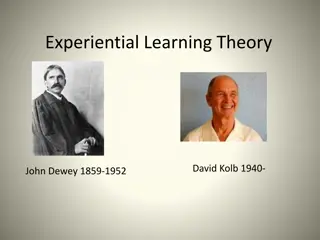Experiential Learning and Stakeholder Engagement Program
This program focuses on experiential learning opportunities, including stakeholder assessment and engagement strategies for successful implementation of research findings. Trainees will learn to identify stakeholders, understand their impact, prioritize engagement, and develop strategies. The program includes practical exercises, case studies, and interactive sessions to enhance skills in stakeholder management. By the end, participants will be equipped to navigate stakeholder relationships effectively in clinical innovation projects.
- Experiential Learning
- Stakeholder Engagement
- Research Implementation
- Training Program
- Stakeholder Assessment
Uploaded on Oct 02, 2024 | 0 Views
Download Presentation

Please find below an Image/Link to download the presentation.
The content on the website is provided AS IS for your information and personal use only. It may not be sold, licensed, or shared on other websites without obtaining consent from the author. Download presentation by click this link. If you encounter any issues during the download, it is possible that the publisher has removed the file from their server.
E N D
Presentation Transcript
Schedule for Experiential Learning Date Timeline Dec 1, 2020 Orientation to your chosen experiential learning opportunity Jan X, 2021 Shared learning session with others completing the same opportunity (Midpoint check-in) Feb X, 2021 5-minute Capstone presentations of your work (slide template will be provided)
Design A Stakeholder Assessment Learning objectives: Identify potential stakeholders who might influence successful implementation of your research findings/results Understand how implementation might be impacted or influenced by each stakeholder Prioritize which stakeholders to engage and create strategies to engage them. Outcome: By the conclusion of this exercise, trainees will be able to identify stakeholders who will need to be engaged if efforts to implement or disseminate a clinical innovation are to be successful.
Process For Conducting a Stakeholder Assessment Trainees will 1. Read a case study and watch a YouTube video example of a stakeholder assessment. 2. Based on your own project, identify at least 3 stakeholders you might need to engage by completing the Stakeholder Management Log. Brainstorm questions you might ask each of the potential stakeholders. 3. Use the stakeholder assessment questions to map these stakeholders on a Stakeholder Grid, given what you know about these stakeholders. 4. Based on your assessment, describe in 2-3 sentences what you might do to engage each of them. Optional Extensions 1. Ask one of your classmates to role-play one of the stakeholders relevant to your project and do a phone interview with your classmate. 2. Reach out to one of the stakeholders relevant to your project and complete a phone interview.
Stakeholder Case Example Optimizing Vascular Access to Prevent Patient Harm This case study of a stakeholder assessment is meant to provide you with an example of the process of identifying who the stakeholders are, why they have an interest in your project/study results, who you should prioritize for engagement and some ideas about how to engage them. Use the case study to help you think about your own project: Who are your stakeholders, Why are they interested, How much influence do they have, How will you engage them?
Completing a Stakeholder Management Log First, complete the section on the left in the Table below from the case study you just finished reading. Then, as you think about your project, identify potential stakeholders you will need to assess and engage with (the right- hand side of the Table) Case Study Example Your Project Why Interested? How much Influence? Why Interested? How Much Influence? Who? Who?
Mapping Stakeholders on a Grid Create a two-by-two grid like the one below, then place the names of your stakeholders in the appropriate spot on the grid. Watch this Video: https://youtu.be/z0u6g8xmNkE Influence Interest
Your Stakeholder Engagement Action Plan Prioritize Who You Need to Engage and Why THEN Plan Activities that might include: Identifying and prioritizing stakeholder interests that need to be discussed. Overcoming resistance by identifying the benefits. Developing discussion questions that are grounded in the perceptions, experiences, and interests of stakeholders. Reviewing research findings and suggesting next steps for implementation. Disseminating and using study findings for improving the fit of your intervention.
Optional Activities Ask one of your classmates to role-play one of the stakeholders you identified as relevant to your project and do a phone interview with them. Ask them these questions and take notes. Write up a short (500 word) summary of the conversation. What do they perceive as the purpose of the results of your project? What concerns, if any, do they have about implementing the findings from your project their setting? What have they heard from others about the results your project? What areas do stakeholders think are important to address first before introducing the results of your project? OR Reach out to one of the actual stakeholders relevant to your project and complete a phone interview. Ask them the above questions and take notes. Write up a short (500 word) summary of the conversation
Your Next Steps Please track how much time you spend on this learning opportunity! We ll ask you to report this at a later evaluation. Come to the mid-point shared learning session to briefly update the group on your progress, discuss challenges, and brainstorm solutions, if needed Ask for help at any point along the way: contact NAME/EMAIL or Michael Parchman: michael.x.parchman@kp.org. Consider extending your experience by interviewing a classmate or a real-life stakeholder. Give a 5-minute presentation on your learnings at a Capstone TL1 Seminar we will provide a template for your presentation (reviewed at mid-point check-in)
Thank You ITHS is supported by the National Center For Advancing Translational Sciences of the National Institutes of Health under Award Number UL1 TR002319. This project was supported by the National Center For Advancing Translational Sciences of the National Institutes of Health under Award Number TL1 TR002318. The content is solely the responsibility of the authors and does not necessarily represent the official views of the National Institutes of Health.




